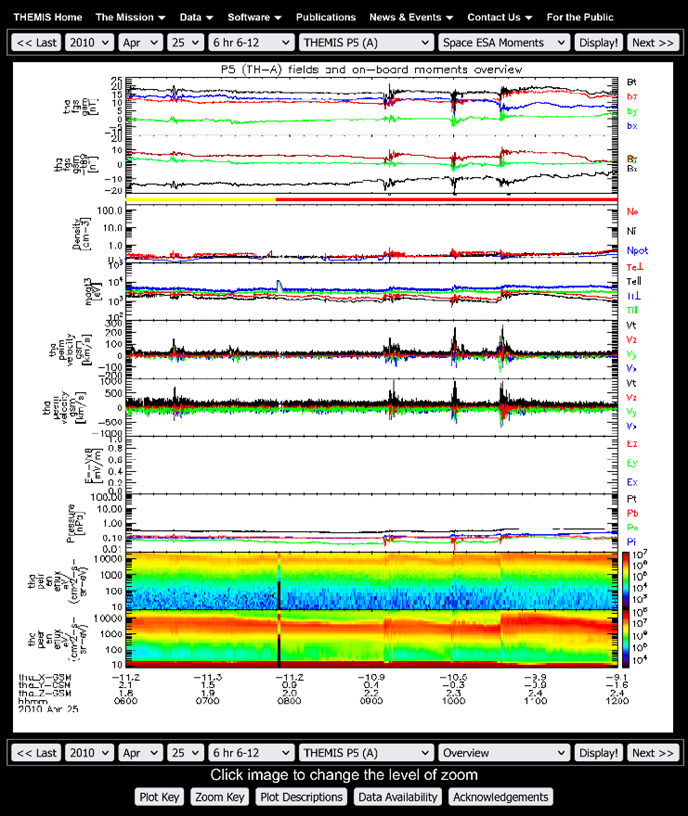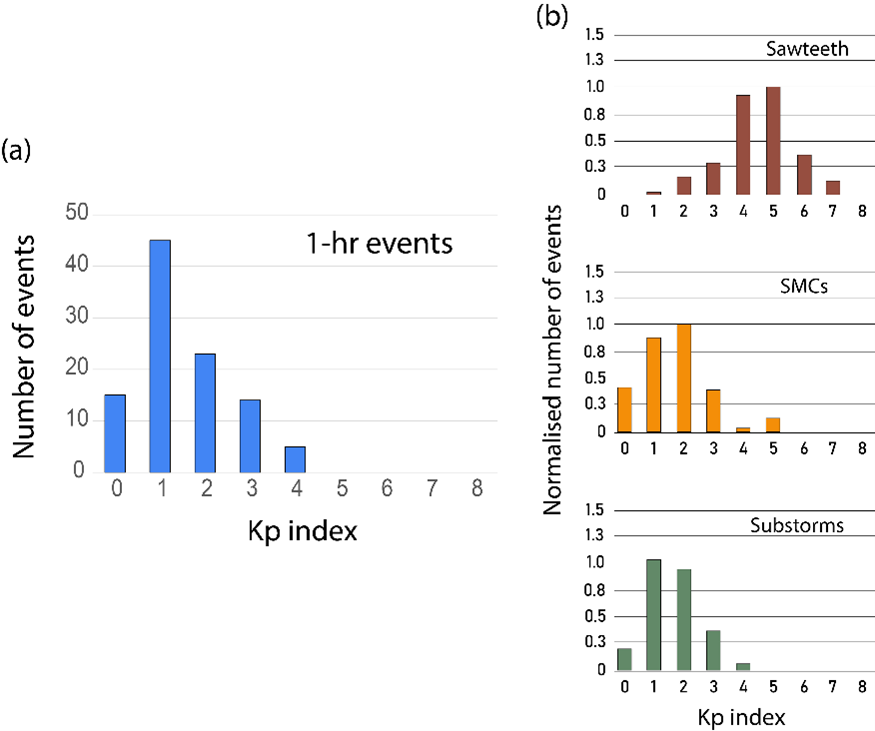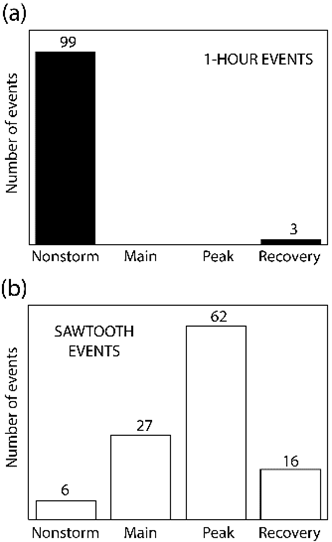
2022 THEMIS SCIENCE NUGGETS
Statistical Properties of 102 SPA Events
by Andreas Keiling
Space Sciences Laboratory, UC Berkeley, California, USA
Introduction
The magnetosphere tends to show certain, repeatable behaviors, called magnetospheric response modes. These modes are of great importance, because they represent manifestations of large energy transport and conversion in the global magnetospheric-ionospheric system. While the sawtooth mode, which is a ~3-hr periodic mode, has been investigated extensively, here we provide statistics on a ~1-periodic response mode, which we term "short-period activation mode" (SPA mode).
| Figure 1. THEMIS user interface showing a 6 –hr overview plot (generated on the THEMIS website at http://themis.igpp. ucla.edu). The periodic dipolarizations between 0900 and 1100 UT constitute one SPA event. |
Results
We identified 102 events in the THEMIS database. The magnetic dipolarization signature at 10 –12 RE in the magnetotail was the defining criterium to identify events in our study. This selection includes proper substorms, pseudobreakups, and substorm intensifications/activations. In addition to dipolarization, the events show particle injections and fast plasma flows (Figure 1). The statistical properties of these events were compared with published results of other magnetospheric response modes to provide context. Distributions of associated Kp (Figure 2) and solar wind speed (not shown here) are similar to those of substorms and very different from those of sawtooth events. It is also found that they are not associated with storms, which again is in contrast to the storm-related sawtooth mode (Figure 3).
| Figure 2. Comparison of Kp distributions for various magnetospheric response modes. (a) Distribution of 102 SPA events (b) (Adapted from Partamies et al., 2009) Normalized distributions for 138 sawtooth events, 149 steady magnetospheric convection events, and 155 substorms. |
| Figure 3. Comparison of storm conditions (as inferred from Dst) for the 1-hr periodic events and sawtooth events. (a) Number of 1-hr events sorted by phase of magnetic storms and nonstorm times. (b) (Modified from Cai et al., 2011) Number of sawtooth events occurring during each phase of magnetic storms and nonstorm times. |
Lastly, we compared our observations with published results of global MHD simulations with kinetic corrections (Kuznetsova et al., 2007). The authors demonstrated a quasi-periodic response in the magnetotail to steady driving conditions by the solar wind and interplanetary magnetic field. The comparison shows significant similarities (Figure 4); thus, suggesting a possible source mechanism for the SPA events. Further details of this study can be found in Keiling et al. (2022).
Conclusion
From our survey of 102 periodic events, the following key points can be made:
- The short-period substorm activity, due to either substorms or substorm-associated disturbances, is a nonstorm phenomenon.
- The periodic events are distinct from other magnetospheric response modes; thus, it is plausible to treat them as a separate response mode.
- Internally driven, quasi-periodic reconnection in the magnetotail is a viable source mechanism.
References
Keiling, A., Ramos, C., Vu, N., Angelopoulos, V., Nosé, M. (2022). Statistical properties and proposed source mechanism of recurrent substorm activity with one-hour periodicity. Journal of Geophysical Research: Space Physics, 127, e2021JA030064.Cai, X., Zhang, J.-C., Clauer, C. R., Liemohn, M. W. (2011). Relationship between sawtooth events and magnetic storms. Journal of Geophysical Research, 116, A07208.
Kuznetsova, M. M., Hesse, M., Rastätter, L., Taktakishvili, A., Toth, G., De Zeeuw, D. L., et al. (2007). Multiscale modeling of magnetospheric reconnection. Journal of Geophysical Research, 112, A10210.
Partamies, N., Pulkkinen, T. I., McPherron, R. L., McWilliams, K., Bryant, C. R., Tanskanen, E., et al. (2009). Different magnetospheric modes: Solar wind driving and coupling efficiency. Annals of Geophysics, 27, 4281–4291.
Biographical Note
Dr. Keiling is a research physicist with the Space Sciences Laboratory at the University of California, Berkeley. His current research interests are magnetosphere-ionosphere coupling, ULF waves, and substorm dynamics in the magnetotail.
 Please send comments/suggestions to
Emmanuel Masongsong / emasongsong @ igpp.ucla.edu
Please send comments/suggestions to
Emmanuel Masongsong / emasongsong @ igpp.ucla.edu



